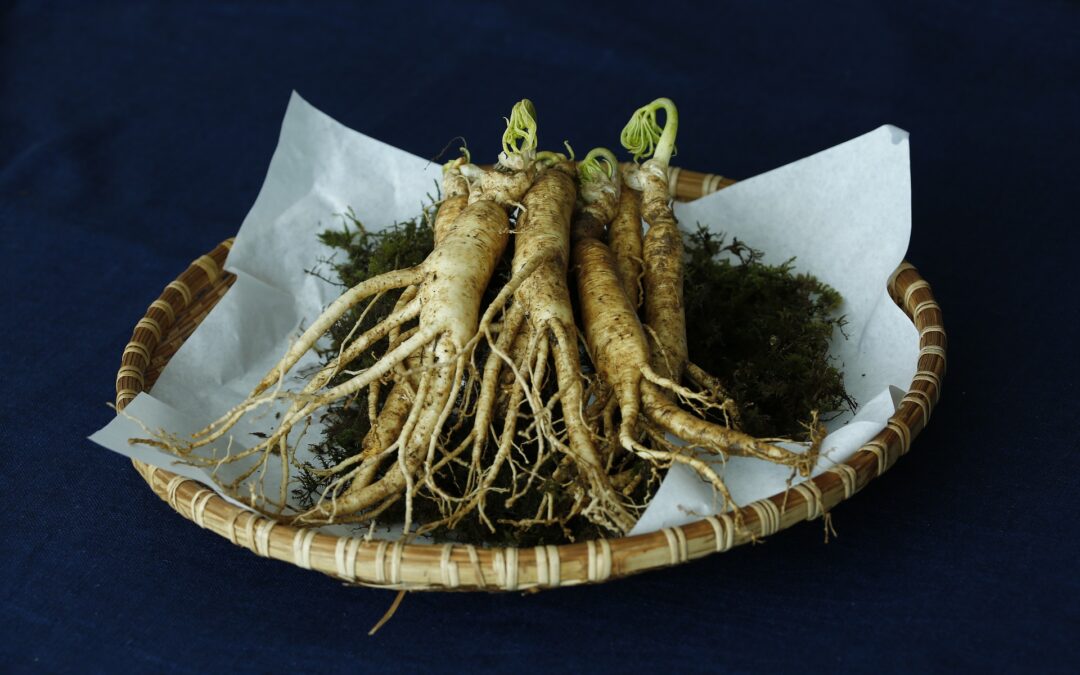Ginseng (Panax ginseng C.A. Meyer) is a perennial from the araliaceae family that once grows wild in eastern Russia, northeastern China, northern Korean peninsula and Japan. Due to its great importance in folk medicine and very high prices, ginseng has been practically exterminated in vast areas. Of the once vast areas of its natural occurrence, only 3 isolated habitats in Russia and China remain.
Currently, ginseng, which is part of various preparations, comes exclusively from cultivation. The largest plantations of this raw material are located in Russia, China, Korea and North America.
Ginseng is a perennial with a whitish, strong, often divided, bulbous root. The stem is up to 50 cm high, leaves five-fingered, serrated, small, greenish flowers from which then the fruits appear in the form of red berries.
The pharmaceutical raw material is just the dried root. Ginseng grows very slowly, the root of an annual plant weighs about 2 g. Roots of 5-6 years old plants with roots weighing 15-20 g are suitable for harvesting. In the past, the roots of several dozen-year-old plants weighing even several hundred grams were the most valued. Now they are practically unattainable, because no one waits with the harvest on plantations, and in wild ginseng stands it is under protection.
Physiologically active ingredients of ginseng
Ginseng saponins
The key active ingredients in ginseng are ginsenosides, which belong to a large group of chemicals called saponins. Generally speaking, they are complex carbohydrates, i.e. compounds consisting of a molecule of alcohol (or phenol) and sugar. It is ginsenosides that affect the central nervous system, regulate metabolism, lower glucose levels, improve muscle function, stimulate the endocrine system and help maintain the proper level of hormones.
In aqueous solutions, saponins reduce surface tension, resulting in a foaming effect, therefore plant organs rich in saponins were used as a substitute for soap and for washing.
Korean ginseng contains also important substances other than ginsenosides, which have anti-cancer, antioxidant, anti-diabetic and anti-inflammatory effects, and even act on haemosatase, i.e. processes that regulate blood flow and clotting.
Application in medicine:
The use of ginseng in medicine perfectly reflects one of its names – omnibus.
It is especially highly valued in Chinese medicine, where it is considered a real panacea for all ailments.
The first evidence of the therapeutic use of ginseng comes from China and dates back to 4,000 or even 5,000 years.
In Europe, ginseng appeared only in the 17th century.
There are many publications in the available literature confirming its beneficial healing properties.

The results of modern research, presented in Kwang-tae CHOI, confirm the beneficial effects of ginseng in the following therapeutic areas:
- Improvement of brain function
Effectively increases learning ability and reduces memory loss
- Improve intellectual capacity
The results of clinical trials on humans show that ginseng increases mental performance (improvement in attention, intellectual performance, quick counting skills).
- Analgesic effect
- Preventing the development of cancer and enhances the body’s anti-cancer resistance
- Effectiveness of inhibiting the growth of cancer cells
- Inhibition of cancer cell metastasis
- Increasing the anti-tumor activity of cytostatics
- Inhibition of drug resistance in neoplasms and reduction of side effects of antineoplastic drugs
- Stimulating immune functions
- Antidiabetic action – effective in lowering high blood glucose levels
- Improvement of liver function
- Regulation of blood pressure
- Anti-fatigue and anti-stress effect
- Treatment of climacteric disorders in women
- Improving male sexual function
- Inhibition of the growth of the AIDS virus (HIV)
- Antioxidant and anti-aging effects
As you can see from the above list, the biological activity of ginseng is very versatile and it completely deserves one of its names – OMNIBUS.
AUTHOR: Dr n. farm Andrzej Tarasiuk




